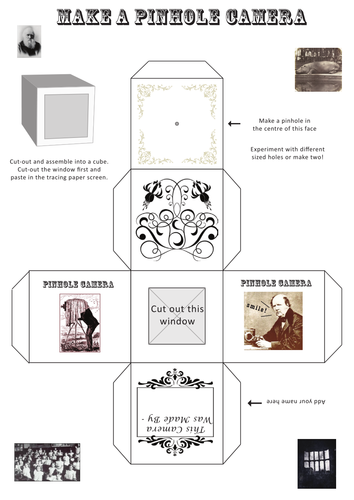Cardboard Pinhole Camera Pdf Free Download Programs
Posted by on Tuesday, November 24, 2015 Book Camera Book Camera — A dream project turned! ^ (or ) For the past couple of months, I’ve been searching for the right sequence of cuts and folds to turn a piece of paper into a camera. Specifically, I wanted to make a working camera within an educational pop-up book—one that connects the dots between design and science / structure and function. Happy to report: it is finally real! The final book explains—and actively demonstrates—how a structure as humble as a folded piece of paper can tap into the intrinsic properties of light to produce a photograph.
Design and Build Your Own Pinhole Camera: Please vote for me in the Hands-On. Applications of this phenomenon; the pinhole camera.

Here is how it works (detailed instructions typed out.) As far as 1800’s tech goes, pinhole photography is an great example of material acting as more than the sum of its parts. If you’re in the market to be blown away by something you normally ignore: over the holiday. You don’t need this book—all that you need is a lightproof box with a hole in the front (mini-hangtag safety pins yield a perfect 0.3–0.4 mm hole) and some light-sensitive material loaded in the back. The results achieved by such humble means is a feat of true cosmic piggybacking—showing that objects we make (even from the most lo-fi materials) can be structured to tap into impressive forces at play in our world.
The 900 ACE is rated at up to 21.8 mpg, 10,8 L/ 100 km)* and the 600 is the most efficient in snowmobiling at up to 29 mpg (8 L/100km)*. Proven Intelligent Throttle Control (iTC) throttle-by-wire technology opens up a new world of customization and drivability options. 2020 Skandic WT Price & Specs| Utility Snowmobile| Ski. Rukovodstvo po remontu snegohoda ski doo skandik wt chart. Both the 900 ACE and 600 ACE four-strokes use Advanced Combustion Efficiency Technology to deliver brisk performance, excellent fuel economy and ultra-low maintenance.
This is an example of the type of photo it takes. Photo taken with an iPhone versus photo taken with a folded-piece-of-paper-in-a-pop-up book: The convex surface of the lens of a normal camera to produce focus at the focal point. A lensless camera accepts light through a single hole in a flat plane (from a single angle.) Because of this, there are no mechanics to “focus” a pinhole camera—it is a projection from a single beam, much like a. The result is that objects near the camera and objects far away from the camera have the same exact amount of focus. Take this image of a fence, the Williamsburg bridge, and the Empire State Building—which is fuzzy, but each structure has an equal degree of focus: To see more results: I’m posting sample photos taken with the cameras with #thisbookisacamera on the. The book itself comes with detailed instructions and a starter pack of (any 4×5” or smaller light-sensitive material can be used).

There is nothing to assemble, but if you want to use it as more than a book, you need to feel alright with the concept of pouring developer into an old takeout food container and sloshing it around in the dark while counting. Been prototyping this for a while, so this totally sounds like a normal human-in-a-dark-room activity. I tested it for a very long time and now my neighbors are probably questioning my sanity: The project was supported in part by the (and produced in multiples by ). Why it works The reason why a hole in a lightproof box can perform a function similar to real photographic equipment is due to light’s intrinsic tendencies. Light steadfastly moves in a perfectly straight line. In a normal environment, light beams bounce around ambiently—their cacophony of trajectories eager to fog a piece of photographic paper with a muddy multitude of images.
The chaos wrought by multiple beams became clear here—where I maladroitly forgot to patch a second pinhole I was testing. A double image was produced: The book explains the tendencies of light beams this way: But Why? Dogovor podryada na vipolnenie visotnih rabot obrazec.
Why work on some piece of antediluvian technology while sitting in a studio surrounded by high-tech tools like lasers, Graphtec cutters, and Illustrator? For the past few years, I’ve been trying to better understand forces at play in the analog world through a process of subtraction. To do this, I’ve been disassembling everyday tools, stripping off their normal interface, and reducing them down to their functional minimums. The value in this eccentric hobby is best illustrated with a past work-example: We frequently take for granted that music occurs because “we pushed play,” but what truly enables sound to reach our ears? In 2011, driven by sheer determination to recreate an experiment from a 1980’s Mr. Wizard episode, I made for my friends Mike and Karen’s wedding. Using only humble materials and handmade construction, this “device” corrals minute soundwave vibrations from a needle up into a paper tunnel, which in turn amplifies those waves into audibility.